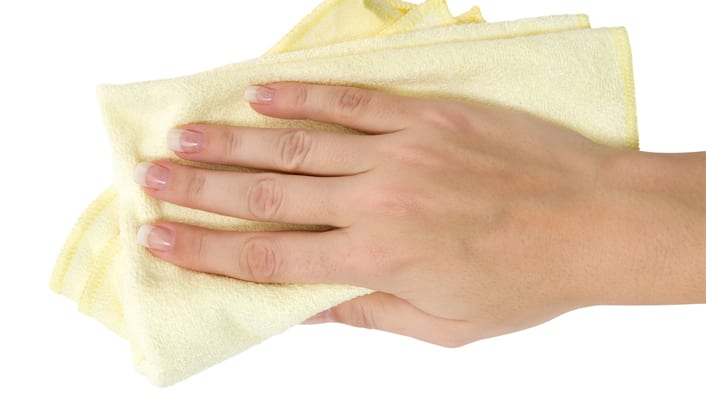
Every now and again you’ll need to clean the inside of your refrigerator. Despite the low temperatures, microorganisms can still multiply. In today’s post, we’ll give you some advice on what to keep in mind when you get the cleaning cloth out.
Refrigerators will inevitably get a little messy – perhaps jam gets stuck on one of the shelves, maybe juice or milk spurts out in the door shelving. It’s time to reach for the cleaning cloth! Even if your fridge isn’t visibly dirty, we recommend that you clean it every four to six weeks. After all, this is where you’re storing fresh food!
Cleaning your refrigerator doesn’t require a huge amount of expertise, and you don’t need to waste money on expensive refrigerator cleaners or disinfectants either. Warm water and a little dish soap are absolutely sufficient.
Preparing To Clean Your Fridge
Get your appliance ready for cleaning – run down food stocks and arrange for remaining foods to be temporarily stored in a thermal bag or a cooler with cold packs – or in the fridge of a friendly neighbor.
Remember, always switch off the refrigerator and unplug it from the mains for safety reasons before you get started, If you have a freestanding appliance, pull it slightly forwards or sideways and then use a vacuum cleaner to remove any dust from underneath it and from the large, black condenser coils at the back.
If your fridge-freezer is not equipped with NoFrost or you have a refrigerator with a freezer compartment, leave it to defrost for several hours before you clean it out.
Cleaning The Fittings
Take out and, where possible, dismantle all removable parts such as shelves, drawers or partitions. Clean these individual fittings in the sink using warm water and a little dish soap or a pH-neutral detergent. Use a damp cloth to clean the telescopic rails. The grease on the tracks is required for lubrication and should not be removed. Use a cotton cloth to dry the parts.
Cleaning The Interior
The best way to clean the interior is with a microfiber cloth, warm water and a little dish soap or pH-neutral detergent.
Using expensive specialist cleaners or disinfectants is not necessary when cleaning refrigerators; warm water and dish soap are sufficient.
After cleaning, wipe out the interior using clean water and dry it with a cloth. It’s not uncommon for household advice websites to suggest cleaning your refrigerator with vinegar: we strongly advise you not to do this as vinegar can sometimes corrode plastics. You should also avoid using scouring pads, abrasive sponges and other aggressive cleaning agents and aids. It is far more important to simply clean your appliance regularly – we recommend every four to six weeks. You can’t actually go far wrong when cleaning your fridge but, to be on the safe side, here are a few things you should avoid:
- Do not use steam cleaners
- Do not use concentrated detergents
- Do not use scourers, abrasive sponges or steel wool
- Do not use harsh or abrasive cleaning agents that contain sand, chloride or acid
- Do not damage or remove the serial plate found on the interior
- Do not allow cleaning water to enter the drainage channel, the ventilation grills or the electrical parts
Cleaning The Exterior
Suitable cleaning of the outside of your appliance depends on the material from which it is made.
Stainless steel doors: These have a SmartSteel finish, which must be treated with care. Wipe them with a soft, clean cloth. If it is necessary to remove tough dirt, use a little water or a pH-neutral cleaner. Please note: You must not use stainless steel cleaner on SmartSteel surfaces. This can damage the SmartSteel finish.
Stainless steel side panels: If the side panels are dirty, clean them using Liebherr stainless steel cleaner (product no. 8409 022 (250 ml)). Apply the cleaner to a soft, cotton cloth and clean the panels in the direction of the grain. Afterwards, use lukewarm water to remove any cleaning agent residue and then re-seal the dry surface with Liebherr stainless steel polish (product no. 8409 028 (1.7 fl. oz) or product no. 8409 030 (8.5 fl. oz)). Again work in the direction of the grain. Both the stainless steel cleaner and the stainless steel polish can be purchased from specialist retailers.
You can also contact us on +1 (866) LIE-BHERR (543-2437, USA) or +1 (888) LIE-BHERR (543-2437, Canada) during normal business hours for further information
REMEMBER: Stainless steel doors on Liebherr appliances have a SmartSteel finish. Do NOT use the steel polish on them, it will damage them.
Note: For appliances with BlackSteel finish, the cleaning instructions for the door apply to the side panels as well.
Painted side panels: Wipe with a soft, clean cloth. In the event of tough dirt, use a little water or a pH neutral detergent.
When You’re Done Cleaning
Once all parts are clean and dry, plug in the appliance and switch it back on. If equipped, turn on the SuperCool and/or SuperFrost function so your appliance reaches its desired temperature quickly. Once the appliance is sufficiently cold, put your food back into it. You can now enjoy a clean appliance and a sense of security as you store and prepare your fresh food!
If you have any questions about refrigerator cleaning, simply write to us! Use the comment function below this post or start/join in discussions with us on Facebook.
Disclaimer: While this article can be applied to brands other than LIEBHERR, it was written with the specifications and design elements of a LIEBHERR product in mind. Not all refrigerators are the same: Always consult the CLEANING & MAINTENANCE (or similar) section of your aplliance’s user manual!A